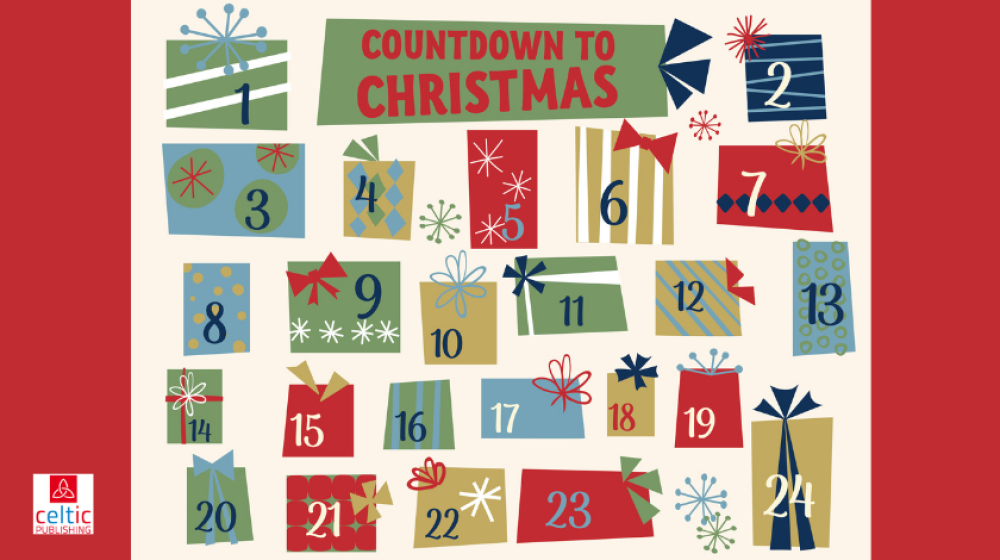Countdown to Christmas - The Advent Calendar

Whenever I don’t feel like planning my lessons, I always remember my tutor at teaching training college in England who would constantly remind me that planning and preparation was the only key to a successful lesson.
It’s early November as I write this and the threat of DAD or DDI is looming… and with it the difficulty of planning motivating lessons.
Our little pupils have already missed out on so much and I really don’t want them to miss out on the fun of Christmas in the air at school.
Fingers crossed they won’t have to and we will be at school in December, but nevertheless, I am trying to think of lessons that can be transferred to online teaching if necessary.
Christmas vocabulary, spelling, prepositions, memory games and for the older ones even extended speaking and writing can all focus around an interactive advent table which is a display the children create together in class, or if necessary, individually at home.
HERE’S HOW TO DO IT:
The children prepare 24 small “stand up” cards and write a date on each one from Tuesday 1st December to Thursday 24th December.
On 1st December they place an angel (drawing, homemade, or one from a Christmas tree) and put it on a table in the classroom (fingers crossed) next to the date card with the word Angel written on it.
On 2nd December they place a bell there with the date card and the written word.
They continue expanding the display in alphabetical order with the following objects which can all be easily substituted with drawings: card, decoration, elf, family, gift, holly, ivy, Jesus, kiss, lights, mistletoe, North Pole, ornaments, present, Queen’s speech, reindeer, Santa, tree, Under the tree (picture with arrow pointing to gift under tree), Winter, Xmas.
You only need to use 24 letters and if you really can’t find something for the difficult letters, just eliminate them and put extra things for the letter “S” for which there are so many.
Through the creation of this display, our children can expand their vocabulary, practise their spelling, improve their memory skills by recalling what is on the table without looking (the objects in alphabetical order help them enormously), rearrange the objects and describe their positions “The angel is next to the bell, Santa is behind the card”, listen to, comprehend and carry out instructions “point to the mistletoe, put the decoration in front of the present,” practise saying and writing the dates and of course, get excited about Christmas.
If we have to do this activity in DAD, the children can create the display themselves, take photos of it which the teacher can share with the class and then they can take turns describing their display to their classmates.
The activities can easily be adapted according to the age and abilities of our pupils.
Maybe, just maybe, my tutor from college would have liked this idea!
VERSIONE IN ITALIANO
LEZIONI DI INGLESE DENTRO E FUORI DALL’AULA: COSTRUIRE IL CALENDARIO DELL’AVVENTO
Di Michelle Slattery
Ogni volta che non ho voglia di pianificare la lezione mi ritorna in mente il mio tutor universitario che costantemente mi ricordava come la programmazione e la preparazione fosse l'unica chiave per realizzare una lezione efficace.
È l'inizio di dicembre mentre scrivo e la minaccia di DAD o DDI incombe ... e con essa la consapevolezza della difficoltà di pianificare lezioni motivanti.
I nostri piccoli alunni hanno già perso così tanto che non voglio davvero si perdano anche il divertimento che solo la magia del Natale è capace di creare a scuola. Incrociamo le dita e speriamo non sia necessario riprogettare le lezioni e che saremo tutti a scuola a dicembre.
Tuttavia, sto cercando di pensare a lezioni che possano essere usate anche per l’insegnamento a distanza, se necessario.
Il vocabolario natalizio, l'ortografia, le preposizioni, i memory game e per i più grandi anche lo speaking e il writing possono essere convogliati in una unica attività: una sorta di “calendario dell’avvento” interattivo che i bambini creano insieme in classe o, se necessario, individualmente a casa.
ECCO COME CREARLO:
I bambini preparano 24 cartoncini e su ognuno scrivono una data che va da martedì 1° dicembre a giovedì 24 dicembre.
Il 1° dicembre prendono un angelo (un disegno, un angelo costruito manualmente o anche la decorazione di un albero di Natale a forma di angelo) e lo posizionano sul banco in classe (incrociamo le dita) accanto al biglietto, con sopra scritta la parola “angel/angelo”.
Il 2 dicembre invece prendono una campana/bell con il cartoncino della data e la parola. Si prosegue giorno dopo giorno con le iniziali successive ad arricchire il vocabolario e con la visualizzazione degli oggetti o in ordine alfabetico.
Gli oggetti possono essere facilmente sostituiti con dei disegni, vi suggerisco, ad esempio, i seguenti:
card, decoration, elf, family, gift, holly, ivy, Jesus, kiss, lights, mistletoe, North Pole, ornaments, present, Queen’s speech, reindeer, Santa, tree, Under the tree (picture with arrow pointing to gift under tree), Winter, Xmas.
Dovresti usare tutte le 24 lettere dell’alfabeto ma se non riesci a trovare qualcosa con le lettere più complesse, eliminale e inserisci al loro posto degli oggetti extra con la lettera "S", ce ne sono davvero tanti con questa iniziale!
Attraverso la creazione di questo calendario i nostri bambini possono ampliare il vocabolario, esercitarsi sull’ortografia, allenare la memoria ricordando ciò che è sul banco senza guardare (gli oggetti in ordine alfabetico saranno di enorme aiuto). Potranno spostare gli oggetti e indicare dove si trovano: “The angel is next to the bell, Santa is behind the card”; ascoltare, comprendere ed eseguire le istruzioni: “Point to the mistletoe, put the decoration in front of the present,”; ma anche esercitarsi a dire e scrivere le date.
Tutto ciò permette di creare anche l’attesa per il magico Natale!
Se dovessimo svolgere questa attività in DAD i bambini possono costruire da soli il calendario dell’avvento, scattare poi una foto che l'insegnante può condividere con l’intera classe e, a turno, descrivere il loro calendario ai compagni di classe.
Le attività possono essere facilmente adattate in base all'età e al livello linguistico dei nostri alunni.
Molto probabilmente, ma non ne ho la certezza, quest’ idea sarebbe piaciuta al mio tutor universitario!




























